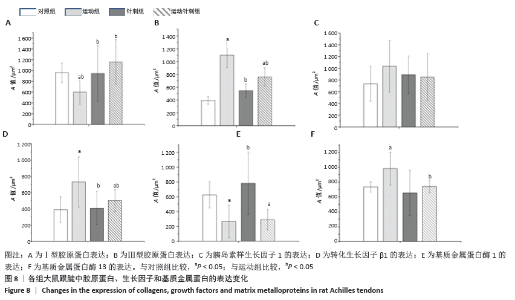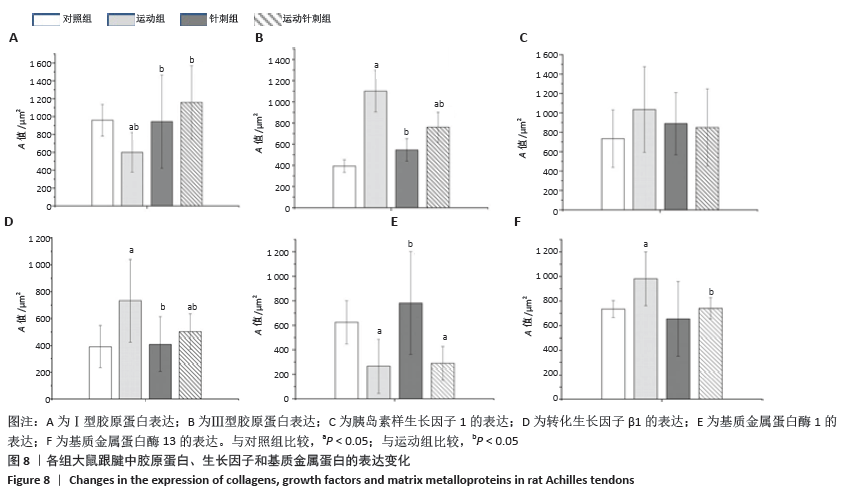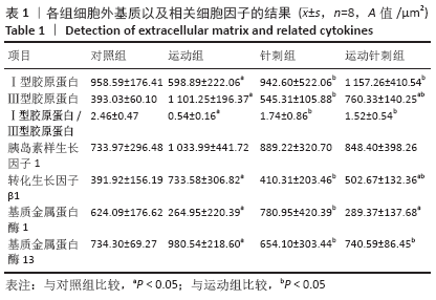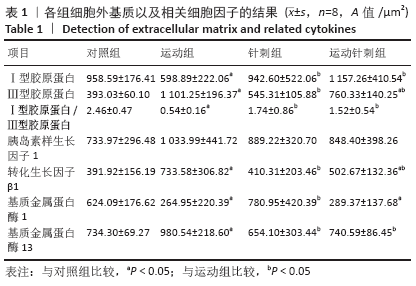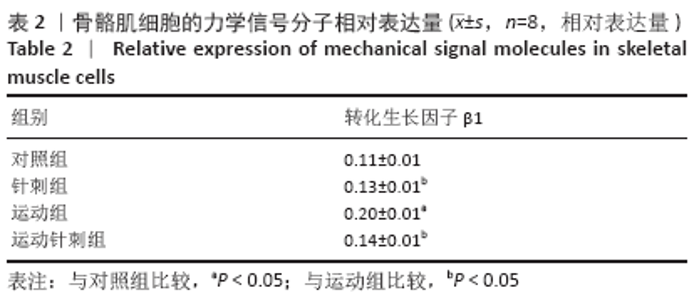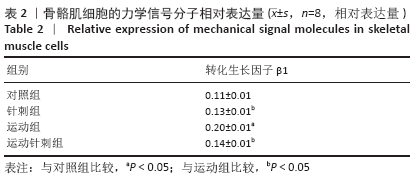Chinese Journal of Tissue Engineering Research ›› 2021, Vol. 25 ›› Issue (14): 2211-2218.doi: 10.3969/j.issn.2095-4344.3146
Previous Articles Next Articles
Effects of post-exercise gastrocnemius needling on Achilles tendon degeneration in obese rats
Liu Yunyi, Wang Bo, Wang Lin
- School of Sports Medicine and Rehabilitation, Beijing Sport University, Beijing 100084, China
-
Received:2019-11-08Revised:2019-11-18Accepted:2020-05-22Online:2021-05-18Published:2020-12-30 -
Contact:Wang Bo, MD, Lecturer, School of Sports Medicine and Rehabilitation, Beijing Sport University, Beijing 100084, China -
About author:Liu Yunyi, Master, School of Sports Medicine and Rehabilitation, Beijing Sport University, Beijing 100084, China
CLC Number:
Cite this article
Liu Yunyi, Wang Bo, Wang Lin. Effects of post-exercise gastrocnemius needling on Achilles tendon degeneration in obese rats[J]. Chinese Journal of Tissue Engineering Research, 2021, 25(14): 2211-2218.
share this article
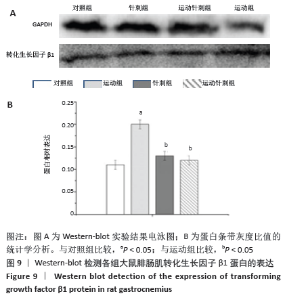
在胶原合成相关的力学生长因子表达方面,运动组的胰岛素样生长因子1表达高于对照组和运动针刺组。转化生长因子β1在运动针刺组和运动组中表达显著高于对照组(P < 0.05),在运动组中表达显著高于运动针刺组(P < 0.05)。在胶原分解相关的基质金属蛋白酶表达方面,基质金属蛋白酶1在运动组和运动针刺组中表达显著低于对照组(P < 0.05),运动组与运动针刺组之间没有显著差。基质金属蛋白酶13在运动组中表达显著高于对照组与运动针刺组(P < 0.05)。 在胶原蛋白表达方面,一方面运动组的Ⅰ型胶原蛋白表达显著低于运动针刺组、对照组与针刺组(P < 0.05);另一方面胶原蛋白Ⅲ的表达在运动组中显著高于运动针刺组和对照组(P < 0.05),导致Ⅰ型胶原蛋白/Ⅲ型胶原蛋白在运动组中要显著低于运动针刺组与对照组(P < 0.05)。 2.4 腓肠肌中力学相关生长因子转化生长因子β1变化 提取大鼠腓肠肌中的蛋白,使用Western Blot以GAPDH为内参进行标准化分析其中的转化生长因子β1蛋白表达的变化,见图9;表2。结果显示腓肠肌中的转化生长因子β1蛋白表达在运动组中显著高于对照组、针刺组和运动针刺组。 "
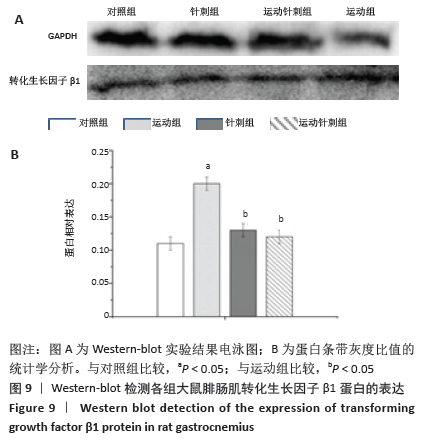
| [1] CHANDRAN A, BARRON MJ, WESTERMAN BJ, et al. Time Trends in Incidence and Severity of Injury Among Collegiate Soccer Players in the United States: NCAA Injury Surveillance System,1990-1996 and 2004-2009l. Am J Sports Med. 2016;44(12):3237-3242. [2] MEHDIZADEH A, GARDINER BS, LAVAGNINO M, et al. Effect of collagen length distribution and timing for repair on the active TGF-β concentration in tendon.Connect Tissue Res. 2018;59(5):396-409. [3] ZHANG ZJ, NG GYF, LEE WC, et al.Increase in passive muscle tension of the quadriceps muscle heads in jumping athletes with patellar tendinopathy. Scand J Med Sci Sports. 2017;27(10):1099-1104. [4] SPRAGUE AL, SMITH AH, KNOX P, et al.Modifiable risk factors for patellar tendinopathy in athletes: a systematic review and meta-analysis. Br J Sports Med. 2018;52(24):1575-1585. [5] STAUBER T, BLACHE U, SNEDEKER JG.Tendon tissue microdamage and the limits of intrinsic repair. Matrix Biol. 2020;85-86:68-79. [6] ZHANG J, YUAN T, WANG JH.Moderate treadmill running exercise prior to tendon injury enhances wound healing in aging rats. Oncotarget. 2016;7(8):8498-8512. [7] SINGH A, CALAFI A,DIEFENBACH C,et al.Noninsertional Tendinopathy of the Achilles. Foot Ankle Clin. 2017;22(4):745-760. [8] DEDERER KM, TENNANT JN. Anatomical and Functional Considerations in Achilles Tendon Lesions. Foot Ankle Clin. 2019;24(3):371-385. [9] THORPE CT, CHAUDHRY S, LEI II, et al.Tendon overload results in alterations in cell shape and increased markers of inflammation and matrix degradation. Scand J Med Sci Sports. 2015;25(4):e381-391. [10] ZERGOUN AA, ZEBBOUDJ A, SELLAM SL, et al. IL-6/NOS2 inflammatory signals regulate MMP-9 and MMP-2 activity and disease outcome in nasopharyngeal carcinoma patients. Tumour Biol. 2016;37(3): 3505-3514. [11] POMIANOWSKA E, SANDNES D, GRZYB K, et al. Inhibitory effects of prostaglandin E2 on collagen synthesis and cell proliferation in human stellate cells from pancreatic head adenocarcinoma. BMC Cancer. 2014;14:413. [12] AKAZAWA N, OKAWA N, KISHI M, et al. Effects of long-term self-massage at the musculotendinous junction on hamstring extensibility, stiffness, stretch tolerance, and structural indices: A randomized controlled trial. Phys Ther Sport. 2016;21: 38-45. [13] ANDRZEJEWSKI W, KASSOLIK K, DZIEGIEL P, et al. Massage may initiate tendon structural changes--a preliminary study. In Vivo. 2015;29(3):365-369. [14] ABATE M, SALINI V, ANDIA I. How Obesity Affects Tendons?.Adv Exp Med Biol. 2016;920:167-177. [15] HSIEH YL, HONG CZ, LIU SY, et al. Acupuncture at distant myofascial trigger spots enhances endogenous opioids in rabbits: a possible mechanism for managing myofascial pain. Acupunct Med. 2016; 34(4):302-309. [16] LIU L, SKINNER MA, MCDONOUGH SM, et al. Traditional Chinese Medicine acupuncture and myofascial trigger needling: The same stimulation points?. Complement Ther Med. 2016;26:28-32. [17] HUNT ER, CONFIDES AL, ABSHIRE SM, et al. Massage increases satellite cell number independent of the age-associated alterations in sarcolemma permeability. Physiol Rep. 2019;7(17): e14200. [18] 杨宁,周越,王瑞元.针刺对骨骼肌拉伤恢复进程中纤维化因子的影响[J].北京体育大学学报,2018, 41(9): 70-74. [19] No authors listed. Eccentric training and an Achilles wrap reduce Achilles tendon capillary blood flow and capillary venous filling pressures and increase tendon oxygen saturation in insertional and midportion tendinopathy. Am J Sports Med. 2007;35(4):673. [20] 白胜超. 一次大负荷离心运动后骨骼肌线粒体分裂的机制及针刺干预研究[D].北京:北京体育大学,2018. [21] D’ADDONA A, MAFFULLI N, FORMISANO S, et al. Inflammation in tendinopathy. Surgeon. 2017;15(5): 297-302. [22] HE R, ZHANG J, LUO D, et al. Upregulation of Transient Receptor Potential Canonical Type 3 Channel via AT1R/TGF- β 1/Smad2/3 Induces Atrial Fibrosis in Aging and Spontaneously Hypertensive Rats.Oxid Med Cell Longev. 2019;2019:4025496. [23] ZHANG J, WANG JH. The Effects of Mechanical Loading on Tendons - An In Vivo and In Vitro Model Study. PLoS One. 2013;8(8):e71740. [24] THAMPATTY BP, WANG JH.Mechanobiology of young and aging tendons: In vivo studies with treadmill running. J Orthop Res. 2018; 36(2):557-565. [25] GUMUCIO JP, SUGG KB, MENDIAS CL. TGF-β superfamily signaling in muscle and tendon adaptation to resistance exercise.Exerc Sport Sci Rev. 2015;43(2):93-99. [26] COCKERILL M, RIGOZZI MK, TERENTJEV EM. Mechanosensitivity of the 2nd Kind: TGF-β Mechanism of Cell Sensing the Substrate Stiffness.PLoS One. 2015;10(10): e0139959. [27] 王雅榕.针刺对急性离心运动骨骼肌胞浆和线粒体中H_2O_2浓度变化的影响[D].济宁:曲阜师范大学,2015. [28] VASSILAKOS G, BARTON ER. Insulin-Like Growth Factor I Regulation and Its Actions in Skeletal Musclel. Compr Physio. 2018;9(1): 413-438. [29] 郭振海,黄昌林,巨文军.运动所致肌腱中内源性IGF-1的表达[J].中国临床康复,2002,6(2):199-200. [30] ONAL ED, IPEK A, EVRANOS B, et al. Structural tendon changes in patients with acromegaly: assessment of Achilles tendon with sonoelastographyl. Med Ultrason. 2016;18(1):30-35. [31] WANG X, LI F, XIE L, et al. Inhibition of overactive TGF-β attenuates progression of heterotopic ossification in mice.Nat Commun. 2018;9(1): 551. [32] WANG X, XIE L, CRANE J, et al. Aberrant TGF-β activation in bone tendon insertion induces enthesopathy-like disease.J Clin Invest. 2018;128(2):846-860. [33] MILLAR NL, MURRELL GA, MCINNES IB. Inflammatory mechanisms in tendinopathy-towards translationl.Nat Rev Rheumatol. 2017;13(2): 110-122. |
| [1] | Shen Jinbo, Zhang Lin. Micro-injury of the Achilles tendon caused by acute exhaustive exercise in rats: ultrastructural changes and mechanism [J]. Chinese Journal of Tissue Engineering Research, 2021, 25(8): 1190-1195. |
| [2] | Liang Xueqi, Guo Lijiao, Chen Hejie, Wu Jie, Sun Yaqi, Xing Zhikun, Zou Hailiang, Chen Xueling, Wu Xiangwei. Alveolar echinococcosis protoscolices inhibits the differentiation of bone marrow mesenchymal stem cells into fibroblasts [J]. Chinese Journal of Tissue Engineering Research, 2021, 25(7): 996-1001. |
| [3] | Duan Liyun, Cao Xiaocang. Human placenta mesenchymal stem cells-derived extracellular vesicles regulate collagen deposition in intestinal mucosa of mice with colitis [J]. Chinese Journal of Tissue Engineering Research, 2021, 25(7): 1026-1031. |
| [4] | Ma Zetao, Zeng Hui, Wang Deli, Weng Jian, Feng Song. MicroRNA-138-5p regulates chondrocyte proliferation and autophagy [J]. Chinese Journal of Tissue Engineering Research, 2021, 25(5): 674-678. |
| [5] | Li Quanxi, Shen Yu, Wan Wei, Sun Shanzhi. Changes of abdominal wall mechanics and pain after tension-free inguinal hernia repair with polypropylene mesh [J]. Chinese Journal of Tissue Engineering Research, 2021, 25(4): 548-552. |
| [6] | Liu Liu, Zhou Qingzhu, Gong Zhuo, Liu Boyan, Yang Bin, Zhao Xian. Characteristics and manufacturing techniques of collagen/inorganic materials for constructing tissue-engineered bone [J]. Chinese Journal of Tissue Engineering Research, 2021, 25(4): 607-613. |
| [7] | Xu Xiaoming, Chen Yan, Song Qian, Yuan Lu, Gu Jiaming, Zhang Lijuan, Geng Jie, Dong Jian. Human placenta derived mesenchymal stem cell gel promotes the healing of radiation skin damage in SD rats [J]. Chinese Journal of Tissue Engineering Research, 2021, 25(25): 3976-3980. |
| [8] | Wang Hao, Chen Mingxue, Li Junkang, Luo Xujiang, Peng Liqing, Li Huo, Huang Bo, Tian Guangzhao, Liu Shuyun, Sui Xiang, Huang Jingxiang, Guo Quanyi, Lu Xiaobo. Decellularized porcine skin matrix for tissue-engineered meniscus scaffold [J]. Chinese Journal of Tissue Engineering Research, 2021, 25(22): 3473-3478. |
| [9] | Chen Lei, Zheng Rui, Jie Yongsheng, Qi Hui, Sun Lei, Shu Xiong. In vitro evaluation of adipose-derived stromal vascular fraction combined with osteochondral integrated scaffold [J]. Chinese Journal of Tissue Engineering Research, 2021, 25(22): 3487-3492. |
| [10] | Yang Li, Li Xueli, Song Jinghui, Yu Huiqian, Wang Weixia. Effect of cryptotanshinone on hypertrophic scar of rabbit ear and its related mechanism [J]. Chinese Journal of Tissue Engineering Research, 2021, 25(20): 3150-3155. |
| [11] | Li Songtao, Li Xinyi, Song Yunfeng, Ning Jiayin, Ren Qiang, Yang Renxu, Peng Bo. Maxing Xiongting Mixture regulates factors relevant to lung reshaping and vascular remodeling of hypoxic pulmonary hypertension rats [J]. Chinese Journal of Tissue Engineering Research, 2021, 25(2): 274-280. |
| [12] | Chen Xinling, Wang Shenglan. Cell autophagy, pathway, regulation and its multiple correlations with pulmonary hypertension [J]. Chinese Journal of Tissue Engineering Research, 2021, 25(2): 311-316. |
| [13] | Liu Zhendong, Wang Rui, Li Xiaolei, Wang Jingcheng. Review of interferon alpha-2b inhibiting scar formation [J]. Chinese Journal of Tissue Engineering Research, 2021, 25(2): 317-321. |
| [14] | Zhong Yuanming, Fu Xiaopeng, Xu Wei, Zhao Qingrui, Huang Yong, Ye Weiquan. Nicardipine controlled hypotension applied to perioperative blood loss in orthopedics: a meta-analysis [J]. Chinese Journal of Tissue Engineering Research, 2021, 25(18): 2930-2937. |
| [15] | Chen Siyu, Li Yannan, Xie Liying, Liu Siqi, Fan Yurong, Fang Changxing, Zhang Xin, Quan Jiayu, Zuo Lin. Thermosensitive chitosan-collagen composite hydrogel loaded with basic fibroblast growth factor retards ventricular remodeling after myocardial infarction in mice [J]. Chinese Journal of Tissue Engineering Research, 2021, 25(16): 2472-2478. |
| Viewed | ||||||
|
Full text |
|
|||||
|
Abstract |
|
|||||














